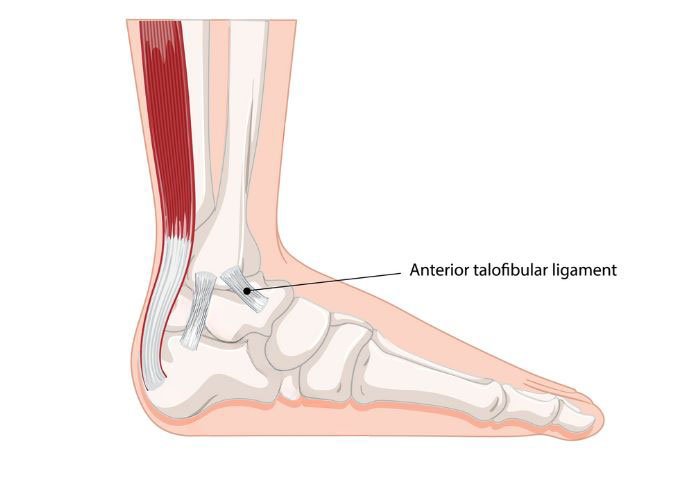



Dr.karnav Panchal is a specialist in knee, hip, shoulder and elbow related problems. After completing his M.S. in orthopedics at B.J. Medical College, one of the prestigious institutes in India, he has been trained in the fields of joint replacement surgeries and sports injuries at Mumbai and South Korea.

You may be suffering from a tear of the ATFL (Anterior Talofibular Ligament) — the most commonly injured ligament in the ankle. It often results from a twisted ankle or sprain and, if left untreated, can lead to chronic instability, recurrent sprains, and long-term joint damage.
Dr. Karnav Panchal, an expert in foot and ankle sports injuries in Ahmedabad, offers precise diagnosis and effective treatment for both acute and chronic ATFL tears, including minimally invasive ligament repair or reconstruction.
The Anterior Talofibular Ligament (ATFL) is one of the key ligaments that stabilizes the outer part of your ankle. It connects the fibula (leg bone) to the talus (ankle bone) and is most commonly damaged during inversion injuries (when your foot rolls inward).
Occurs due to a sudden twisting or sprain
Usually happens during sports, running, or missteps
Often seen with swelling, bruising, and pain
Result of untreated or repeated ankle sprains
Ligament becomes loose or scarred
Leads to chronic instability and frequent ankle giving-way
Sudden inversion injury (common in football, basketball, running)
Walking or running on uneven surfaces
High-impact sports
Improper footwear or lack of ankle support
Previous ankle sprains or trauma
Hyperlaxity (naturally loose ligaments)
Sharp pain on the outer side of the ankle
Swelling and bruising within hours
Difficulty bearing weight
Tenderness over the ATFL area
Frequent ankle sprains
Sensation of ankle “giving out”
Persistent pain and instability
Difficulty in running or side-to-side movement
Weakness and swelling with activity
Detailed clinical examination and ligament stress tests
MRI Scan to assess ligament tear, swelling, and other joint structures
Ultrasound (in some cases) to check dynamic movement
Accurate diagnosis is key to determining if you need conservative care or surgical intervention.
Rest, Ice, Compression, Elevation (RICE)
Ankle brace or support
Physiotherapy to strengthen ankle and restore balance
Anti-inflammatory medications
Activity modification
✅ Effective in mild to moderate acute injuries
✅ Avoids surgery if healing progresses well
Sutures used to reattach the torn ligament
Minimally invasive, keyhole approach
Performed for fresh, clean tears
Uses nearby tendons or grafts to reconstruct the torn ligament
Ideal for chronic instability or failed repairs
Provides long-term stability and return to full activity
✅ Restores ankle strength and prevents re-injury
✅ High success rate in athletes and active individuals
Prevents recurrent ankle sprains
Restores balance, strength, and mobility
Allows safe return to sports
Reduces long-term risk of ankle arthritis or deformity
Improves confidence and performance
You may be a candidate for surgical repair or reconstruction if:
You have repeated ankle sprains
You feel your ankle is constantly “giving way”
You’re an athlete or highly active individual
MRI shows a complete or chronic tear
Conservative treatment has failed over 3–6 months
✅ Sports injury specialist with a focus on ankle ligament injuries
✅ Expertise in arthroscopic and minimally invasive ATFL repair
✅ Personalized rehabilitation plans
✅ Excellent outcomes in both athletes and non-athletes
✅ Trusted across Ahmedabad, Gujarat, and beyond
Conservative care: 3–6 weeks for mild sprains
Surgical repair: Weight-bearing in 2–3 weeks, sports by 3–4 months
Full recovery with rehab: ~4–6 months for high-demand athletes
From Ahmedabad to Surat, Rajkot to Udaipur, patients trust Dr. Karnav Panchal for precise, effective management of ankle ligament injuries, including ATFL tears and chronic instability.
Yes, partial or mild tears often heal with bracing, rest, and therapy. Severe or chronic tears may need surgery.
Most procedures take 45–90 minutes and are performed as day-care surgeries.
Yes. With proper rehab, patients typically return to full activity within 4–6 months.
Pain is mild and managed with medications. Early mobilization reduces stiffness.
Yes, especially after anatomic reconstruction, your ankle can regain near-normal strength and stability.